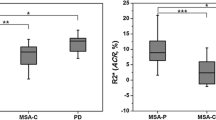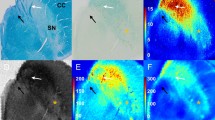Abstract
Introduction
Posterior putaminal atrophy, putaminal T2-hyper and/or hyposignal changes have been observed in patients with multiple system atrophy (MSA) with parkinsonism.
Methods
Postmortem T2-weighted images were compared with histological findings in seven autopsy-proven cases of putaminal lesions of MSA. All cases were evaluated on 1.5T magnetic resonance imaging (MRI) scanners and three cases were evaluated on 3T scanners.
Results
There were three types of putaminal changes: Type 1, mild putaminal atrophy and isointensity; Type 2, putaminal atrophy and diffuse hyperintensity with a hyperintense putaminal rim (HPR); Type 3, putaminal atrophy and iso-or-hypointensity with HPR. The signal intensities of the putamen in Types 1 and 3 were more hypointense on 3T images than on 1.5T images. In Type 1, mild putaminal atrophy showed mild neuronal loss and gliosis and diffuse ferritin deposition. In Types 2 and 3, the areas of putaminal atrophy, severe in the posterior region, showed severe neuronal loss and gliosis, many pigments that were positive for ferritin and Fe 3+ and diffuse ferritin deposition. Although, tissue rarefaction was more severe in Type 2 than in Type 3, pigment deposition was more severe in Type 3. The HPR showed a severe loss of myelin and axons with tissue rarefaction of the external capsule or putaminal rim in Types 2 and 3.
Conclusion
Posterior putaminal atrophy reflects neuronal loss and gliosis. While putaminal iso-or -hypointensity reflects diffuse ferritin and Fe3+ deposition, hyperintensity reflects tissue rarefaction. The HPR reflects degeneration of the putaminal lateral margin and/or external capsule. These findings reflect characteristic histological findings of MSA with parkinsonism.





Similar content being viewed by others
References
Papp MI, Kahn JE, Lantos PL (1989) Glial cytoplasmic inclusions in the CNS of patients with multiple system atrophy (striatonigral degeneration, olivopontocerebellar atrophy and Shy-Drager syndrome). J Neurol Sci 94:78–100
Dickson DW, Lin W, Liu WK, Yen SH (1999) Multiple system atrophy: a sporadic synucleinopathy. Brain Pathol 9:721–732
Gilman S, Low PA, Quinn N, Albanese A, Ben-Shlomo Y, Fowler CJ et al. (1999) Consensus statement on the diagnosis of multiple system atrophy (review). J Neurol Sci 163:94–98
Schrag A, Kingsley D, Phatouros C, Mathias CJ, Lees AJ, Daniel SE, Guinn NP (1998) Clinical usefulness of magnetic resonance imaging in multiple system atrophy. J Neurol Neurosurg Psychiatry 65:65–71
Savoiardo M, Strada L, Girotti F, Zimmerman RA, Grisoli M, Testa D, Petrillo R (1990) Olivopontocerebellar atrophy: MR diagnosis and relationship to multiple system atrophy. Radiology 174:693–696
Kraft E, Schwarz J, Trenkwalder C, Vogl T, Pfluger T, Oertel WH (1999) The combination of hypointense and hyperintense signal changes on T2-weighted magnetic resonance imaging sequences. Arch Neurol 56:225–228
Schrag A, Kingsley D, Phatouros C, Mathias CJ, Lees AJ, Caniel SE, Quinn NP (1998) Clinical usefulness of magnetic resonance imaging in multiple system atrophy. J Neurol Neurosurg Psychiatry 65:65–71
Naka H, Ohshita T, Murata Y, Imon Y, Mimori Y, Nakamura S (2002) Characteristic MRI findings in multiple system atrophy: comparison of the three subtypes. Neuroradiology 44:204–209
Bhattacharya K, Saadia D, Eisenkraft B, Yahr M, Olanow W, Drayer B, Kaufmann H (2002) Brain magnetic resonance imaging in multiple-system atrophy and Parkinson disease. A diagnostic algorithm. Arch Neurol 59:835–842
Yagishita A (1994) MR-pathologic correlations of putaminal lesion in multiple system atrophy (in Japanese). Pathol Clin Med 12:327–334
Konagaya M, Sakai M, Matsuoka Y, Goto Y, Yoshida M, Hashizume Y (1999) Pathological correlate of the slitlike changes on MRI at the putaminal margin in the multiple system atrophy (in Japanese). J Neurol 246:142–143
Schwarz J, Weis S, Kraft E, Tatsch K, Bandmann O, Mehraein P, Vogl T, Oertel WH (1996) Signal changes on MRI and increases in reactive microgliosis, astrogliosis, and iron in the putamen of two patients with multiple system atrophy. J Neurol Neurosurg Psychiatry 60:98–101
Lang AE, Curran T, Provias J, Bergeron C (1994) Striatonigral degeneration: deposition in putamen correlate with the slit-like void signal of magnetic resonance imaging. Can J Neurol Sci 21:311–318
Martin WR, Roberts TE, Ye FQ, Allen PS (1998) Increased basal ganglia iron in striatonigral degeneration: in vivo estimation with magnetic resonance. Can J Neurol Sci 25:44–47
Blamire AM, Rowe JG, Styles P, McDonald B (1999) Optimising imaging parameters for post mortem MR imaging of the human brain. Acta Radiol 40:593–597
Fearnley JM, Lees AJ (1990) Striatonigral degeneration. A clinicopathological study. Brain 113:1823–1842
Wenning GK, Seppi K, Tison F, Jellinger K (2002) A novel grading scale for striatonigral degeneration (multiple system atrophy). J Neural Transm 109:307–320
Haque TL, Miki Y, Kanagaki M, Takahashi T, Yamamoto A, Konishi J, Nozaki K, Hashimoto N, Konishi J (2003) MR contrast of ferritin and hemosiderin in the brain: comparison among gradient-echo, conventional spin-echo and fast spin-echo sequences. Eur J Radiol 48:230–236
Kato S, Meshitsuka S, Ohama E, Tanaka J, Llena JF, Hirano A (1992) Increased iron content in the putamen of patients with striatonigral degeneration. Acta Neuropathol 84:328–330
Lowe JS, Leigh N (2002) Multiple system atrophy. In: Graham DI, Lantos PL (eds) Green field’s neuropathology, 7th edn. Edward Arnold, London, pp 343–346
Lee WH, Lee CC, Shyu WC, Chong PN, Lin SZ (2005) Hyperintense putaminal rim sign is not a hallmark of multiple system atrophy at 3T. AJNR Am J Neuroradiol 26:2238–2342
Fujii S, Matsusue E, Kinoshita T, Sugihara S, Ohama E, Ogawa T (2007) Hyperintense putaminal rim at 3T reflects fewer ferritin deposits in the lateral marginal area of the putamen. AJNR Am J Neuroradiol 28:777–781
Acknowledgements
We are grateful to Eiji Yamashita, B.S., Naoki Iwata, B.S., Takuro Tanaka, B.S., Hiroki Katayama, B.S., and Takeshi Yamane, B.S., for technical support in obtaining high-quality MR images for this study.
Conflict of interest statement
We declare that we have no conflict of interest.
Author information
Authors and Affiliations
Corresponding author
Rights and permissions
About this article
Cite this article
Matsusue, E., Fujii, S., Kanasaki, Y. et al. Putaminal lesion in multiple system atrophy: postmortem MR-pathological correlations. Neuroradiology 50, 559–567 (2008). https://doi.org/10.1007/s00234-008-0381-y
Received:
Accepted:
Published:
Issue Date:
DOI: https://doi.org/10.1007/s00234-008-0381-y




